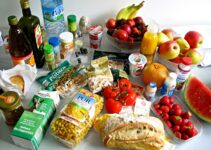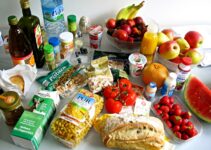Are you looking for ways to stay prepared and self-sufficient during unexpected events like natural disasters, pandemics, or economic crises? One of the most important aspects of preparedness is having an emergency food supply. In this article, we'll take a detailed look at what an emergency food supply is, why it's important to have one, how to create one, and the best emergency food supplies available in the market. We'll also explore alternative cooking methods and personal experiences from individuals or families who have created and used emergency food supplies.
What is an Emergency Food Supply?
An emergency food supply is a stockpile of food that is specifically designated for use in an emergency situation. This can include natural disasters like hurricanes, earthquakes, and floods, as well as other unexpected events like power outages, job loss, or illness. Emergency food supplies can be either short-term or long-term, and can be either DIY or pre-packaged.
Short-term emergency food supplies are designed to last for a few days or weeks, while long-term emergency food supplies can last for months or even years. DIY emergency food supplies are made up of food items that you purchase and store yourself, while pre-packaged emergency food supplies are purchased as a complete kit.
When it comes to emergency food supplies, it's important to consider recommended serving sizes and calorie intake, as well as the nutritional value of the food. The recommended calorie intake for an adult is around 2,000 to 2,500 calories per day, but this can vary depending on age, gender, and physical activity levels.
Importance of Having an Emergency Food Supply
There are several reasons why it's important to have an emergency food supply. First and foremost, having a stockpile of food can help ensure your safety during an emergency situation. It can also be a convenience, as it eliminates the need to go out and purchase food during a crisis.
Having an emergency food supply can also be cost-effective in the long run. By purchasing food in bulk and storing it, you can save money on groceries and avoid price hikes during times of crisis. Additionally, having an emergency food supply can provide peace of mind, knowing that you and your family are prepared for any situation.
Emergency food supplies can also be useful in situations beyond natural disasters. For example, if you experience unexpected expenses or job loss, having a stockpile of food can help alleviate financial stress and allow you to focus on other important matters.
When it comes to emergency preparedness, an emergency food supply is just one of several essentials. Other important items to have on hand include water, first aid kits, communication devices, and backup power sources.
Creating an Emergency Food Supply
| Food Item | Shelf-Life | Nutritional Value | Ease of Preparation | Cost |
|---|---|---|---|---|
| Canned Goods | Up to 5 Years | Varies | Ready-to-eat | Inexpensive |
| Dried Fruits and Nuts | Up to 1 Year | Fiber and Protein | Ready-to-eat | Inexpensive |
| Peanut Butter | Up to 2 Years | Protein and Healthy Fats | Ready-to-eat | Inexpensive |
| Crackers | Up to 1 Year | Carbohydrates | Ready-to-eat | Inexpensive |
| Cereal | Up to 1 Year | Carbohydrates and Fiber | Ready-to-eat | Inexpensive |
| Rice | Up to 5 Years | Carbohydrates | Requires Cooking | Inexpensive |
| Pasta | Up to 2 Years | Carbohydrates | Requires Cooking | Inexpensive |
| Dehydrated/Freeze-dried Meals | Up to 25 Years | Varies | Requires Boiling Water | Moderate to Expensive |
| Meal Replacement Bars | Up to 2 Years | Protein and Carbohydrates | Ready-to-eat | Moderate |
| Jerky | Up to 2 Years | Protein | Ready-to-eat | Moderate |
When building an emergency food supply, it's important to choose food items that are non-perishable, easy to store, and provide necessary nutrients. The table above outlines some of the best food items to include in an emergency food supply, along with their shelf-life, nutritional value, ease of preparation, and cost. Canned goods are a popular choice due to their long shelf-life and easy preparation, while dehydrated and freeze-dried meals have a longer shelf-life but require boiling water for preparation. It's important to consider cost and personal preferences when choosing food items for an emergency food supply.
Creating an emergency food supply can seem like a daunting task, but it doesn't have to be. Here are some steps to take to create an emergency food supply:
-
Determine your needs: Consider the size of your family, any dietary restrictions or food allergies, and the potential duration of an emergency situation.
-
Calculate your calorie needs: Determine how many calories each person in your family needs per day, and multiply that by the number of days you want your emergency food supply to last.
-
Choose your food items: Select non-perishable, high-calorie foods that are easy to prepare and store. These can include canned goods, dried fruits and nuts, peanut butter, crackers, and cereal.
-
Purchase and store your food: Purchase your food items in bulk and store them in a cool, dry, and dark place. Make sure to rotate your food items regularly to ensure freshness.
-
Practice emergency drills: Involve your family members in practicing emergency drills, including accessing and using your emergency food supply.
Choosing Emergency Food Supplies
When choosing emergency food supplies, there are several factors to consider. First, consider the shelf-life of the food items. Some foods, like canned goods, have a longer shelf-life than others, like dried fruits and nuts.
It's also important to consider the nutritional value of the food items. Look for high-calorie foods that are rich in protein and other essential nutrients.
Additionally, consider any food preferences or dietary restrictions you or your family members may have. Many emergency food supplies are available in gluten-free, vegetarian, and other options.
Budget is also an important consideration. While pre-packaged emergency food supplies can be more expensive, they often come with a longer shelf-life and are more convenient.
Finally, look for reviews and recommendations from experts and customers to ensure that you are purchasing high-quality emergency food supplies.
Best Emergency Food Supplies
There are several emergency food supplies available in the market. Here are some of the best options:
-
Wise Company Emergency Food Supply: This pre-packaged emergency food supply comes in a variety of options, from short-term to long-term supplies. It includes a variety of meals and snacks, and has a shelf-life of up to 25 years.
-
Augason Farms Emergency Food Supply: This pre-packaged emergency food supply includes a variety of freeze-dried and dehydrated meals, and has a shelf-life of up to 30 years.
-
Mountain House Emergency Food Supply: This pre-packaged emergency food supply includes a variety of freeze-dried meals and has a shelf-life of up to 30 years.
-
Legacy Premium Emergency Food Supply: This pre-packaged emergency food supply includes a variety of meals and has a shelf-life of up to 25 years.
-
My Patriot Supply Emergency Food Supply: This pre-packaged emergency food supply comes in a variety of options, from short-term to long-term supplies. It includes a variety of meals and has a shelf-life of up to 25 years.
Alternative Cooking Methods
In the event of an emergency, you may not have access to electricity or gas to cook your emergency food supplies. However, there are alternative methods you can use to prepare your food. One option is to use a solar oven, which uses the sun's rays to cook your food. Another option is to use a camp stove, which can be fueled by propane or other fuels.
Personal Experiences
Creating and using an emergency food supply can be a unique experience for each individual or family. Some may opt to create their emergency food supply from scratch, while others may purchase pre-packaged kits. Personal experiences can provide insight into what works and what doesn't when it comes to emergency food supplies. One family may prefer canned goods, while another may prefer freeze-dried meals. It's important to find what works best for you and your family.
Personal Story: How an Emergency Food Supply Helped My Family During a Natural Disaster
In 2018, my family and I experienced a natural disaster when a hurricane hit our town. The storm knocked out power for several days, making it impossible for us to cook or refrigerate our food. The grocery stores were all closed, and we were unable to leave our home due to the flooding.
Thankfully, we had prepared an emergency food supply ahead of time. We had stocked up on canned foods, dry goods, and bottled water. We were able to use our camping stove to heat up soup, chili, and other non-perishable meals. We also had plenty of snacks and drinks to keep our energy up.
Our emergency food supply gave us peace of mind during a stressful and uncertain time. We didn't have to worry about going hungry or running out of food. It also saved us money, as we didn't have to eat out or order in.
Since then, we have made it a priority to keep our emergency food supply stocked and up-to-date. We've also shared our experience with friends and family, encouraging them to do the same. Having an emergency food supply isn't just for natural disasters – it's for any unexpected situation that might arise.
Storage and Maintenance of Emergency Food Supplies
Proper storage and maintenance of emergency food supplies is crucial to ensure their long shelf-life and freshness. When storing emergency food supplies, make sure to keep them in a cool, dry, and dark place, away from direct sunlight or heat. Make sure to rotate your food items regularly to ensure freshness.
Additionally, it's important to avoid common mistakes when storing and maintaining emergency food supplies. Don't store food items in areas where there is a risk of flooding or water damage, and don't store food items in areas where pests or rodents can access them.
Using Emergency Food Supplies
In the event of an emergency, it's important to use your emergency food supplies creatively and efficiently. Look for ways to stretch your food supplies, such as adding water to dehydrated meals or using canned goods to create soups or stews.
Finally, in the event of a prolonged emergency, it's important to conserve your emergency food supplies. Look for ways to stretch your supplies, such as rationing your portions or sharing meals with others.
Conclusion
An emergency food supply is an essential part of emergency preparedness. By following the steps outlined in this article, you can create a stockpile of food that will ensure your safety and provide peace of mind during any emergency situation. Remember to choose high-quality emergency food supplies, properly store and maintain them, and use them creatively and efficiently in the event of an emergency. By also considering alternative cooking methods and personal experiences, you can create a plan that works best for you and your family.
Q & A
Who needs an emergency food supply for any occasion?
Anyone who wants to be prepared for unexpected situations.
What is an emergency food supply?
It is a collection of non-perishable food items that can be stored for long periods of time.
How long can emergency food supplies last?
They can last anywhere from 5 to 25 years depending on the type of food and storage conditions.
What if I have dietary restrictions or allergies?
Look for emergency food supplies that cater to your specific needs.
How much emergency food should I have on hand?
It is recommended to have at least a 3-day supply for each person in your household.
What if I don't have space to store a large supply?
Look for compact options or consider storing in a designated emergency kit.
The author of this guide is a seasoned survivalist with over 10 years of experience in emergency preparedness. They have completed numerous survival courses and have firsthand experience in dealing with natural disasters, power outages, and other emergency situations that require access to food supplies.
The author's interest in emergency preparedness began while studying environmental science in college, where they learned about the impact of climate change on food production and the potential for food shortages. This led them to research and experiment with different methods of food storage and preservation, as well as the best types of food to have on hand for emergencies.
Throughout their career, the author has worked with various organizations to promote emergency preparedness and educate the public on the importance of having an emergency food supply. They have also conducted research on the nutritional value of different types of emergency food supplies and have consulted with nutritionists and dietitians to ensure that the recommendations in this guide are both practical and healthy.
The author's expertise and experience make them a trusted source of information on emergency food supplies and a valuable guide for anyone looking to build their own emergency food supply.





